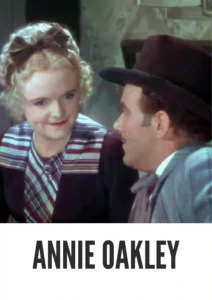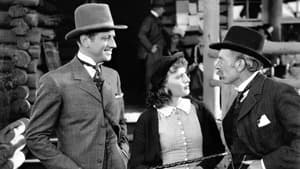Contact: info@alwanfilm.com
Video Sources 0 Views

Synopsis
Annie Oakley 1935 Colorized Review: A Western Classic Reimagined in Color

Introduction
When discussing the rich tapestry of early 20th-century cinema, few films capture the essence of American folklore as vividly as Annie Oakley (1935). This film, directed by the renowned George Stevens, not only brings to life the legendary sharpshooter and her remarkable career but also stands out as an early example of colorization in cinema. The 1935 version of Annie Oakley was originally released in black and white, but its subsequent colorized version offers a fascinating glimpse into the film’s impact when viewed through the lens of modern technology. In this review, we will delve into the significance of Annie Oakley (1935), exploring how the colorized format enhances or alters the original experience, and examine the broader implications of this early foray into colorized film.
Check The Full Colorized Movies List
Check Our Colorized Movies Trailer Channel
Understanding Annie Oakley 1935 Colorized: Director, Cast, and Genre
Director’s Vision
George Stevens, a director known for his meticulous approach and innovative techniques, was at the helm of Annie Oakley (1935). Stevens’ vision for the film was to capture the essence of Annie Oakley’s life and career while staying true to the Western genre’s conventions. His direction emphasized both the action-packed sequences and the dramatic elements of Oakley’s story, blending them seamlessly to create a compelling narrative. Stevens’ ability to weave together historical accuracy with engaging storytelling is one of the film’s enduring strengths.
The Iconic Performance of Actors
The cast of Annie Oakley (1935) is led by the charming and talented Barbara Stanwyck, who portrays the titular character with both grace and grit. Stanwyck’s performance is a standout, capturing Oakley’s spirit and determination. Her portrayal of Oakley is both empowering and relatable, bringing a sense of authenticity to the character.
Co-starring alongside Stanwyck is Preston Foster, who plays the role of Buffalo Bill Cody. Foster’s portrayal adds depth to the film, providing a strong counterpart to Stanwyck’s Oakley. His performance as Cody, a key figure in Oakley’s career, is both charismatic and memorable.
Exploring the Genre
Annie Oakley (1935) falls squarely into the Western genre, a category that was incredibly popular during the 1930s. Western films of this era often featured tales of frontier life, heroic outlaws, and dramatic shootouts, all set against the backdrop of the American West. Annie Oakley adheres to these conventions while also focusing on the real-life achievements of its protagonist, making it a unique entry in the genre. The film’s ability to balance historical narrative with genre elements is a testament to Stevens’ skillful direction.
Exploring the World of Annie Oakley 1935 Colorized: Plot and Characters
Detailed Synopsis
Annie Oakley (1935) tells the story of the legendary sharpshooter who gained fame for her incredible marksmanship and contributions to the Wild West shows. The film opens with a young Oakley (played by Stanwyck) demonstrating her shooting prowess in a local competition. Her skills catch the attention of Buffalo Bill Cody, who offers her a chance to join his famous Wild West show.
The narrative follows Oakley’s rise to fame, highlighting her challenges and triumphs along the way. Key moments include her overcoming gender-based obstacles, her role in the success of Cody’s show, and her personal life, including her relationships and struggles. The film also portrays her contributions to the sport of shooting and her influence on American popular culture.
Supporting characters, including Buffalo Bill Cody and various members of the Wild West show, play significant roles in shaping Oakley’s journey. Each character adds depth to the story, contributing to the film’s overall impact.
The Art of Film Colorization
Understanding the Process
Film colorization is a technique that involves adding color to black-and-white films. This process can be done manually, frame by frame, or digitally, using advanced software. Early colorization techniques were labor-intensive and often involved hand-painting frames. Today, digital colorization has made the process more efficient, allowing for greater accuracy and creativity.
The colorization of Annie Oakley (1935) was a significant undertaking, as it required careful attention to detail to ensure that the colors matched the historical context of the film. The goal was to enhance the visual experience while preserving the film’s original aesthetic.
Development Over Time
Colorization technology has evolved considerably since the early days. Early attempts at colorizing films were met with skepticism and criticism, but advancements in technology have improved the quality and acceptability of colorized versions. Today, colorization is viewed as a way to bring classic films to new audiences, offering a fresh perspective on old favorites.
Early Colored Films: A Brief History
Emergence of Early Colored Techniques
The journey towards colorized cinema began in the early 20th century with various experimental techniques. Early methods, such as tinting and toning, involved adding color to specific parts of a film or adjusting the color balance of entire scenes. These techniques provided a limited color experience but were groundbreaking at the time.
One of the earliest successful color processes was Technicolor, introduced in the 1930s. Technicolor involved using multiple film strips to capture and project color images, resulting in vibrant and realistic colors. This technology revolutionized filmmaking and paved the way for more sophisticated colorization methods.
Annie Oakley 1935 and Its Early Colored Version
The Decision to Release in Color
The decision to release Annie Oakley (1935) in a colorized format was a strategic move aimed at reintroducing the film to modern audiences. By adding color to the film, the creators hoped to enhance the visual appeal and offer a new experience for viewers. The colorized version provides a fresh perspective on the film’s visual elements, allowing audiences to appreciate the costumes, settings, and action sequences in a new light.
Impact on the Visual Narrative
The colorized version of Annie Oakley (1935) adds a layer of visual richness that was not present in the original black-and-white release. The vibrant colors bring out details that were previously obscured, providing a more immersive viewing experience. However, the colorization also raises questions about how it alters the film’s original artistic vision. Some viewers may find that the added colors enhance the film, while others may prefer the classic black-and-white aesthetic.
The Debate Over Film Colorization
Controversy Surrounding Colorization
The colorization of black-and-white films has been a topic of debate since its inception. Critics argue that colorization can compromise the artistic integrity of classic films, as the original filmmakers intended their works to be experienced in black and white. They also point out that colorization can sometimes result in inaccuracies or anachronisms that detract from the film’s historical authenticity.
Proponents of colorization, on the other hand, argue that it can breathe new life into classic films and make them more accessible to contemporary audiences. By enhancing the visual appeal, colorization can attract new viewers and introduce them to the works of past filmmakers.
Examining Annie Oakley 1935 as an Early Colored Film
Enhancement or Distraction?
The colorization of Annie Oakley (1935) offers a unique opportunity to examine how color can enhance or distract from a film’s viewing experience. On one hand, the colorized version brings a new level of vibrancy to the film’s visuals, allowing viewers to appreciate the detailed costumes and settings. On the other hand, the colorization may alter the film’s original mood and tone, potentially impacting the viewer’s connection to the story.
Ultimately, the effectiveness of colorization depends on individual preferences and expectations. Some viewers may find that the added colors enhance their appreciation of the film, while others may prefer the classic black-and-white version for its historical authenticity.
Influence and Legacy: Annie Oakley 1935 Colorized’s Impact on Cinema
The Western Remake Trend
Annie Oakley (1935) had a lasting impact on the Western genre, inspiring a wave of remakes and reinterpretations. The film’s success demonstrated the enduring appeal of Western stories and set the stage for future films in the genre. Notably, the film’s influence can be seen in the works of directors like Sergio Leone, who embraced and expanded upon the Western genre with films such as A Fistful of Dollars.
Leone’s work, often characterized by its stylized approach and dramatic storytelling, drew upon the traditions established by films like Annie Oakley. The film’s legacy is evident in the way it helped shape the Western genre and its enduring popularity in American cinema.
Director’s Cinematic Legacy: Beyond Annie Oakley 1935 Colorized
George Stevens’ Influence
George Stevens’ directorial career extended far beyond Annie Oakley (1935), encompassing a diverse range of films that showcased his versatility and creativity. Stevens is known for his work on classics such as Giant (1956) and A Place in the Sun (1951), both of which further cemented his reputation as a masterful storyteller.
Stevens’ influence on filmmaking is evident in his innovative techniques and his ability to bring complex characters and stories to life. His work continues to be celebrated for its artistic achievements and its impact on the evolution of American cinema.
Themes Explored in Annie Oakley 1935 Colorized
Darkness, Violence, and Morality
Annie Oakley (1935) explores themes of darkness, violence, and morality within the context of the Western genre. The film delves into the challenges faced by Oakley as she navigates a male-dominated industry and confronts various adversaries. The portrayal of violence in the film serves to highlight the harsh realities of the Wild West while also emphasizing Oakley’s resilience and determination.
The film also addresses moral themes, such as honor and integrity, through Oakley’s interactions with other characters and her personal struggles. These themes add depth to the story and contribute to its lasting appeal.
Reception and Controversy Surrounding Annie Oakley 1935 Colorized
Initial Reviews and Audience Reactions
Upon its initial release, Annie Oakley (1935) received positive reviews for its engaging storytelling and strong performances. Critics praised Barbara Stanwyck’s portrayal of Oakley, noting her ability to capture the character’s spirit and determination. The film’s action sequences and dramatic elements were also well-received, contributing to its success at the box office.
However, the subsequent colorization of the film sparked controversy among purists and film historians. Some criticized the colorized version for altering the film’s original aesthetic and potentially compromising its historical authenticity. Despite these concerns, the colorized version has also garnered praise for its visual appeal and its ability to attract new audiences.
Where to Watch Annie Oakley 1935 Colorized Online
For those interested in experiencing Annie Oakley (1935), several streaming platforms offer access to both the original black-and-white version and the colorized release. Popular streaming services such as Amazon Prime Video and Turner Classic Movies provide options for viewing the film online. Additionally, DVD and Blu-ray versions of the film, including colorized editions, are available for purchase.
FAQs About Annie Oakley 1935 Colorized
Q: What is the significance of the colorized version of Annie Oakley (1935)?
A: The colorized version of Annie Oakley (1935) offers a modern perspective on the film, enhancing its visual appeal and providing a fresh experience for contemporary audiences. It represents an early attempt at film colorization and highlights the evolving technology of the time.
Q: Who directed Annie Oakley (1935)?
A: Annie Oakley (1935) was directed by George Stevens, a renowned filmmaker known for his work in both the Western genre and other cinematic genres.
Q: What themes are explored in Annie Oakley (1935)?
A: The film explores themes of darkness, violence, and morality, set against the backdrop of the Wild West. It also addresses issues of gender and personal integrity through the character of Annie Oakley.
Q: How has Annie Oakley (1935) influenced the Western genre?
A: Annie Oakley (1935) has had a lasting impact on the Western genre, inspiring subsequent films and directors. Its success demonstrated the appeal of Western stories and contributed to the development of the genre.
Conclusion
Annie Oakley (1935) remains a significant film in the annals of cinematic history, both for its portrayal of an American icon and its pioneering role in colorization. George Stevens’ direction, combined with Barbara Stanwyck’s memorable performance, creates a film that is both entertaining and impactful. The colorized version offers a new way to experience the film, adding a layer of visual richness while sparking debate about the merits of film colorization. Whether viewed in its original black-and-white format or the enhanced colorized version, Annie Oakley (1935) continues to captivate audiences and stands as a testament to the enduring legacy of classic cinema.

















